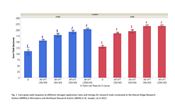Benefits Of Split Application Of Nitrogen In Louisiana Corn
RASEL PARVEJ
BATON ROUGE, LOUISIANA
For corn production in Louisiana, it is recommended to apply nitrogen (N) in at least 2 splits during the growing season to reduce losses and increase N use efficiency. However, many producers apply the total amount anywhere from corn emergence to V6 stage (6 visible collar leaves and plant is about 12-18 inches tall). In an ideal year with moderate temperature and adequate and evenly distributed rainfall, a single application of the total N can be good enough to reach the yield goal especially in moderately fine to fine textured soils such as silty loam to clay with cation exchange capacity (CEC) >10.
However, corn in coarse textured soils such as loamy sand to sandy loam with CEC < 10 should receive N in 2-3 splits to minimize losses and ensure adequate supply during the growing season.
Corn produces different yield components at different stages of plant growth with the most important yield component, kernel rows/ear being set from V1 to V7 stages, potential kernels/row from V7 to tasseling, and harvestable kernels/row from tasseling to R3 stages. Adequate supply of N before the onset of each yield component is very important. If a corn plant senses insufficient N in soils, it can adversely affect the development of each yield component. In other words, production of a particular yield component at a specific growth stage is greatly reduced if N deficiency occurs at that growth stage.
Considering season-long N uptake curve and yield component development, corn requires a small amount of N from planting to V7 stage to maximize kernel rows/ear, a high amount of N from V7 to tasseling to maximize potential kernels/row, and another small amount of N from tasseling to R3 to fill maximum amount of kernels/row. If all N is applied during V6-7 stage, as many producers do, the target to maximize kernel rows/ear will be missed. Providing all the N at or right after planting can target all the yield components but practically more N will undergo loss mechanisms than crop uptake due to a small root system with small N demand early in the growing season. To ensure maximum development of all the yield components, an ideal 2-way split application should include a small amount of N (~15% of the total) during planting and the rest (~85% of the total) during V6-7 stage. If a producer had to apply all the N a few days after corn emergence due to time limitation and equipment/management issues, they should apply ¾ of the total N at this time and the rest ¼ during pre- tassel (V10-12); but this practice is not recommended.
Considering producers’ limitation and issues, we established two corn trials in 2021 at the Macon Ridge Research Station (MRRS) in Winnsboro and Northeast Research Station (NERS) in St. Joseph. These trials were conducted in silt loam soils with 38- or 40-inch-wide beds at both locations. Our results showed that a split application of 90 lb N/acre a few days after planting (AP) plus 60 lb N/acre before tasseling (V10-12; PT) yielded statistically similar compared to a full rate of N (200 lb/acre) few days after planting (AP) plus 60 lb/acre before tasseling (PT) at both locations (Fig. 1). According to LSU AgCenter current recommendations (1 lb of N per bushel of corn harvested for silt loam soils), around 200 to 220 lb N/acre was recommended to produce the maximum yield at both locations but we were able to reach our targeted yield with application of only 150 lb N/acre in 2-splits.
Although this type of splitting is not recommended (mentioned above), our 1-yr 2-sites results highlight the importance of splitting N application in Louisiana corn production. Adequate N amount with proper timing would reduce our N fertilizer needs and maximize yield and profit especially when fertilizer price is at a record high. ∆
Rasel Parvej, Syam Dodla, Matthew Foster, and Rezaul Karim Louisiana State University AgCenter Scientists

Fig. 1. Corn grain yield response to different nitrogen application rates and timings for research trials conducted at the
Macon Ridge Research Station (MRRS) in Winnsboro and Northeast Research Station (NERS) in St. Joseph, LA in 2021.